How to Praise and Reward Your Dog
By Michele Welton, Dog Trainer, Breed Selection Consultant, Author of 15 Dog Books
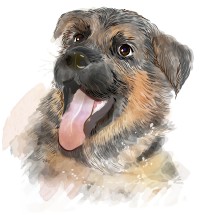 We've been focusing on handling undesirable behavior, but we mustn't take good behavior for granted.
We've been focusing on handling undesirable behavior, but we mustn't take good behavior for granted.
Good behavior is much more likely to be repeated if you let your pup know that you like it.
Think of how pleased you feel when your spouse says, "That was a great dinner, hon" or "Thanks for raking the lawn, sweetheart – it looks so nice." Or when your boss says, "Hey, great job on that report."
Praise your pup when he does something you like, even if it's as simple as resting quietly on his bed, chewing on his bone, or sitting peacefully beside the cat. By praise, I just mean saying, "Yes. Good." Don't make a speech!
The energy level of your voice matters
When you want activity from your pup, use an animated voice.
Suppose he's across the yard. You call him and when he starts toward you, praise him. Now, if you just said "Good dog" in a bored tone, that's not very motivating, is it? But he might break into an enthusiastic run if you call happily, "Yes! GOOD boy! Yay!"
When you want calmness from your pup, use a calm voice.
Suppose he's resting on his bed. If you burst into "Yay! What a good dog you are!", your nice relaxed dog might leap up and begin cavorting around the room. That's counter-productive. When he should be calm and he IS being calm, be quietly approving: "Gooood boy. Good."
Some scenarios call for both calmness and animation.
For example, during a potty break, as your pup squats to pee, give a word of approval in a low-key voice. You don't want him excited or distracted at that particular moment!
But when he's completely done, then you can exclaim, "Yes! Good boy! You did it!" in your animated voice, accompanied by a treat and then a minute or two of fun play.
Are treats necessary to train a dog?
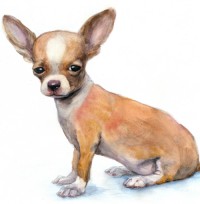 No. As your pup tries different behaviors throughout the day, your job is simply to give a thumbs-up or a thumbs-down.
No. As your pup tries different behaviors throughout the day, your job is simply to give a thumbs-up or a thumbs-down.
We talked about how to give a thumbs-DOWN in this article on corrections.
So what does a thumbs-UP look like? Many pups are perfectly content for your thumbs-up to be a word of approval, a rub of their ears, an affectionate tickle under their chin, a scratch of their chest, a gentle thump of their shoulder, or a toss of their favorite toy.
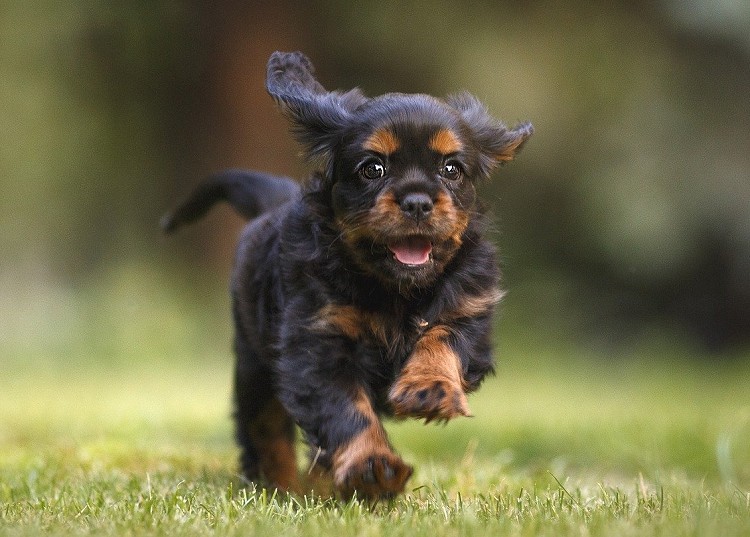
And yet.... most pups do learn more quickly and eagerly when you use food. But to avoid relying on food, you need to progress from constant treating (every time) to variable treating (every other time, or every third time) to random treating (only occasionally).
When you shouldn't use food
- Don't use food when your pup is doing (or just finished doing) a behavior you don't like. For example, if your pup is (or has just been) nipping at your hands or jumping on you or barking, don't give him a treat. Dogs look for patterns and repeat behaviors that result in food.
- Don't use food when your pup is acting afraid of something. No, the food won't "reassure" him. Instead, it reinforces his fearful behavior and you'll see more fear, not less.
- Don't use food if your pup gets over-excited by it. Some pups, when they see food, will persistently jump and whine and turn off their brain. With these pups, use treats minimally, if at all.
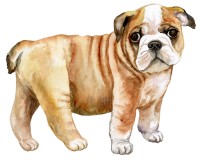 Don't use food as a bribe. A bribe is when you show the dog a treat and then give him a command. Many pups are happy to obey "Sit" as long as you're waving a treat. If they don't see the treat, they may say, "Pfft... why should I?"
Don't use food as a bribe. A bribe is when you show the dog a treat and then give him a command. Many pups are happy to obey "Sit" as long as you're waving a treat. If they don't see the treat, they may say, "Pfft... why should I?"
Now... having said that, when you're first teaching a word and what it means, you can use a treat to "lure" your pup into the right position.
But once he clearly understands, you want to phase out the treats. Like this:
Once your pup understands a command, hide the food until AFTER he has obeyed it. So, say "Sit" but don't even move your hand toward your pocket where the treats are. After the pup sits, say, "Yes!" or "Good!" Then reach into your pocket for the treat.
Summary... Say the word. Pup does the behavior. Praise. Reach for the treat. That way, you're not bribing the dog and you can easily phase out the treats.
What kind of food rewards should you use?
Some people use dry kibble. They measure out what the pup would have eaten that day. But instead of feeding it at regular meals, they dole it out one kibble at a time all through the day, whenever the pup does a desirable behavior.
Using kibble can work. But I don't do it because...
- First, I don't recommend feeding kibble to dogs.
- Second, kibble takes too long to chew. Often the pup dribbles pieces onto the floor, then snuffles around for the crumbs, rather than paying attention to me. I prefer food rewards to be soft so a dog can eat them quickly.
I like treats to be tiny. Then the pup can enjoy lots of rewards for good behavior, without getting fat or too full for his regular meals. Boiled or baked chicken works great for most pups – tiny pieces about ½ the size of your thumbnail.
I put a handful of treats in a sandwich-size plastic baggie, then tuck the bag into my front pocket so the mouth of the bag is somewhat open to quickly reach in and grab a treat.
Food shouldn't be your only reward
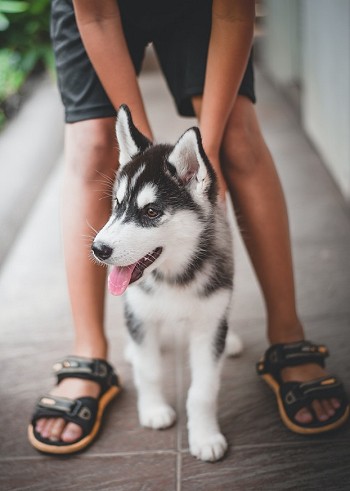
Don't be so eager to pop a treat into your pup's mouth that you forget about the more personal rewards you can offer.
Instead of a treat, you can fondle your pup's ears... scratch his chest... rub his sides... or scritch under his chin.
And don't forget the verbal praise! These "old-fashioned" rewards are time-honored ways to express approval and appreciation to your dog.
But just as there are some pups who get over-excited about food, some pups get over-stimulated by petting and will keep jumping around and nudging for more. If petting distracts your pup from paying attention, keep your hands off him so he can focus on the lesson.
If your dog is difficult to motivate
This is often a shock to people with food-crazy pups, but some dogs are NOT interested in treats. Granted, this may be just a matter of trying different kinds.
Hint... many pups dislike commercial treats but are happy to take bits of real cooked chicken.
But if your pup isn't food-focused, try rewarding with a toy or game. For example, you call your pup from across the yard and he comes galloping to you, whereupon you toss his favorite toy for him to fetch. Or you engage with him in a short, vigorous game of Tug.
If your pup isn't motivated by either treats or toys, don't despair. Dogs have been trained for centuries without using either. My first few dogs were among the happiest and best-behaved dogs I've ever had and I used neither treats nor toys for their training. Instead I just used verbal praise and physical touch.
And if he isn't motivated by praise or touch either? Then I won't lie to you: training is going to be a challenge!
Your dog deserves a leader who is fair and just. We correct bad behavior, yes, but we also reward good behavior with praise, petting, treats, toys, or games. That's balanced training. Dogs love a clear distinction between behaviors that result in rewards, and behaviors that result in corrections. Only then do they have enough information to make good choices.
My best-selling books – now available FREE on my website
 Respect Training For Puppies: 30 seconds to a calm, polite, well-behaved puppy is for puppies 2 to 18 months old. Your puppy will learn the 21 skills that all family dogs need to know. Click here to read for free.
Respect Training For Puppies: 30 seconds to a calm, polite, well-behaved puppy is for puppies 2 to 18 months old. Your puppy will learn the 21 skills that all family dogs need to know. Click here to read for free. Teach Your Dog 100 English Words is a unique Vocabulary and Respect Training Program that will teach your adult dog to listen to you and do what you say. Click here to read for free.
Teach Your Dog 100 English Words is a unique Vocabulary and Respect Training Program that will teach your adult dog to listen to you and do what you say. Click here to read for free. 11 Things You Must Do Right To Keep Your Dog Healthy and Happy helps your dog live a longer, healthier life. Get my honest advice about all 11 Things before you bring home your new puppy, because some mistakes with early health care cannot be undone. Click here to read for free.
11 Things You Must Do Right To Keep Your Dog Healthy and Happy helps your dog live a longer, healthier life. Get my honest advice about all 11 Things before you bring home your new puppy, because some mistakes with early health care cannot be undone. Click here to read for free.
